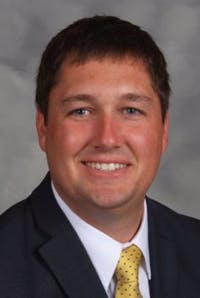The challenge for manufacturers in these challenging days is twofold: continuing the business of providing needed supplies for medical and other mission critical industries, and doing so in a safe working environment. Erik VanLaningham, vice president of global marketing for industrial automation at Emerson, and Chris Hartlage, the firm’s director for global business development assembly technologies, discussed with Machine Design the need to stay on task to deliver on these multiple goals in a time of global crisis.
Machine Design: Assess the current demand in the market for PPE and hospital equipment. What are we talking about in terms of magnitude during the COVID-19 crisis?
Hartlage: The coronavirus pandemic has triggered a looming shortage of non-woven protective medical safety gear, like face masks, face shields, disposable hygiene products and gowns. The urgent need has led numerous manufacturers to increase production of the products that keep healthcare professionals safe.
Emerson offers Branson ultrasonic welding equipment that can slit, bond, seal or quilt non-woven synthetic materials, like those used in medical PPE. As the need for PPE has increased, we’ve seen our current customers increase production of these critical medical garments and protective gear. Branson is also seeing higher demand from new clients in parallel industries, as well as manufacturers in different industries that have the capacity to make products that help meet the global COVID-19 challenge.
MD: How and why did Emerson get involved as a solution provider for these markets?
Hartlage: Branson ultrasonic equipment uses friction and pressure to bond or quilt materials together without the use of adhesives or sealants, which can increase material costs and raise the risk of introducing contaminants. Ultrasonic welding can also be an ideal alternative to sewing. That traditional process creates tiny holes that create the potential for microscopic contaminants to travel through the fabric. Branson’s equipment eliminates those holes to help lower contamination risk.
Nonwovens were already one of the fastest growing segments in Emerson’s space. Our experience and global footprint positioned us to quickly ramp up production in response to the COVID-19 crisis. In addition, while many of our current customers use custom Branson configurations, our team developed some standard ultrasonic welding assemblies that allow new customers to increase production quickly.
MD: How are you able to quickly ramp up production to meet demand and yet keep workers safe? How has the manufacturing process changed to meet these dual needs?
VanLaningham: At Emerson, the health and safety of our team is our top priority. We’re working closely with public health officials in the cities and countries where we operate to ensure employee safety and business continuity.
Flexibility has been the real key to ramping up production without sacrificing health and safety. We’ve made shift and time adjustments in our manufacturing facilities that allow us to maintain production while giving employees the ability to deal with scheduling challenges, like childcare needs.
We’ve also been able to rely on the flexibility we had already built into our production facilities. Much of our manufacturing is set up in different cells, and many of those cells can be worked by a single person. This lets us meet customer demand while adhering to social distancing guidelines. Emerson has also increased cleaning and sanitation of common areas and workspaces as well as provided additional PPE, like gloves, when needed.
MD: In what other markets has Emerson seen an increase in business as a result of COVID-19? How are those challenges being met?
VanLaningham: Emerson ASCO and AVENTICS products are providing key life sciences and laboratory technologies, such as ventilators, respirators, testing equipment and hospital beds. As a result, our fluid control and pneumatic technologies are under extra production, despite challenges like the sudden shift to remote work.
For example, we saw an almost immediate and significant increase in demand for miniature fluid control valves, which are used in breathing therapy products, such as portable oxygen concentrators and ventilators. The top 20 market leaders globally in the analytical medical space need to meet this unprecedented increase in demand and volume—and they turn to Emerson in these difficult times, for support from brands like ASCO and Aventics which they know and trust to meet this challenge. Emerson’s ASCO Series 202 Preciflow IPC proportional valve is designed specifically for mixing/blending ventilator applications—just one of many examples of our unique miniature fluid control technology at Emerson.
MD: Perhaps it’s too soon to truly evaluate this, but are there lessons Emerson as an organization is learning from this crisis, both in terms of manufacturing and in terms of operations?
Hartlage: The coronavirus pandemic has underscored the importance of serving as a true collaborative partner, ready and able to support customers even in uncertain times. For example, our online shop has been key to our ability to meet the needs of this fast-changing environment. The e-shop allows customer to easily and quickly access and specify products. That capability is supported by our in-house design engineers who, even though they now work remotely, can rapidly engineer prototypes and configured products.
The crisis has also reinforced the value of flexibility in the ability to transition quickly to meet critical demands. From working with suppliers to ensure the supply chain to adapting work schedules to providing employees with additional safety equipment when needed, it’s been impressive to see how quickly the Emerson team has shifted for the current situation. And we’ve done it while maintaining the highest levels of customer service and engagement.
One particular challenge for Emerson is making sure our supply chain can help us meet the demand generated by new manufacturers that may come online to answer ever-growing needs related to the situation, from ventilators and single-use drug technology for increased demand in Life Science or packaging, and processed products like disinfectants, tissues and air purifiers.


